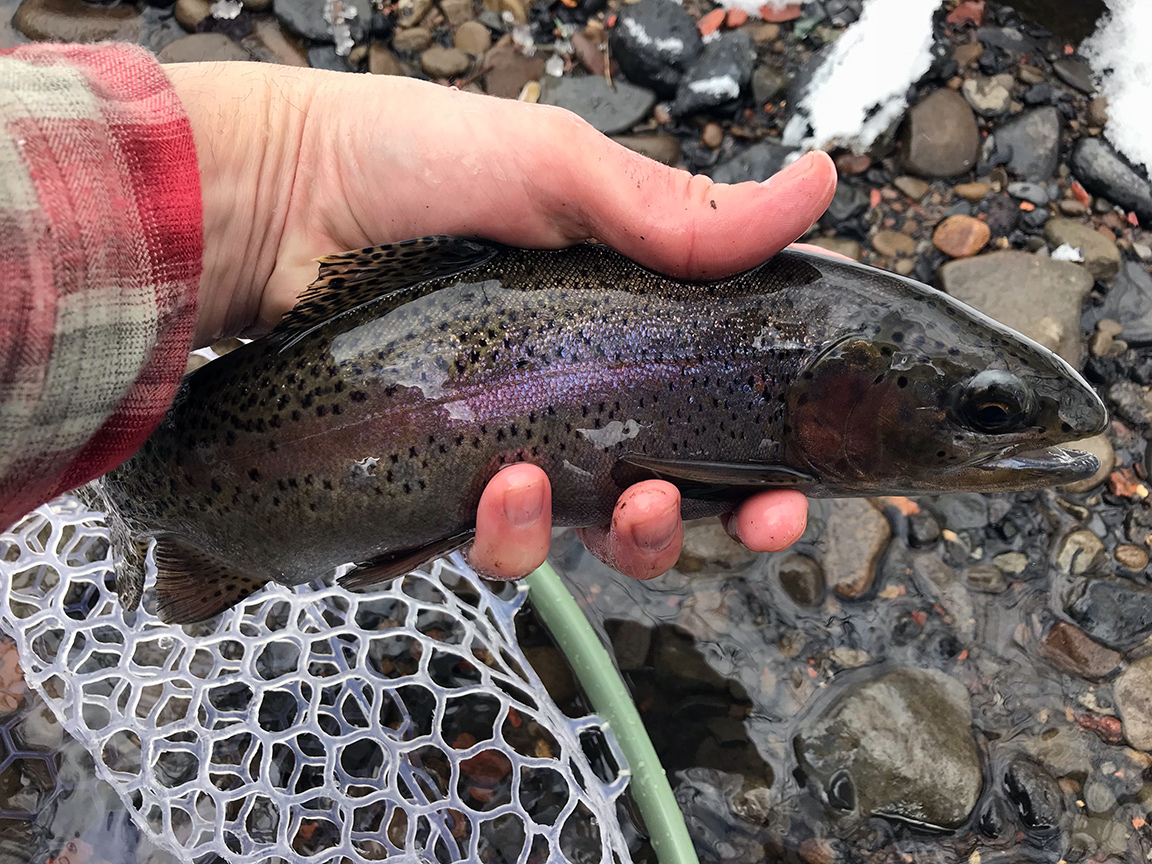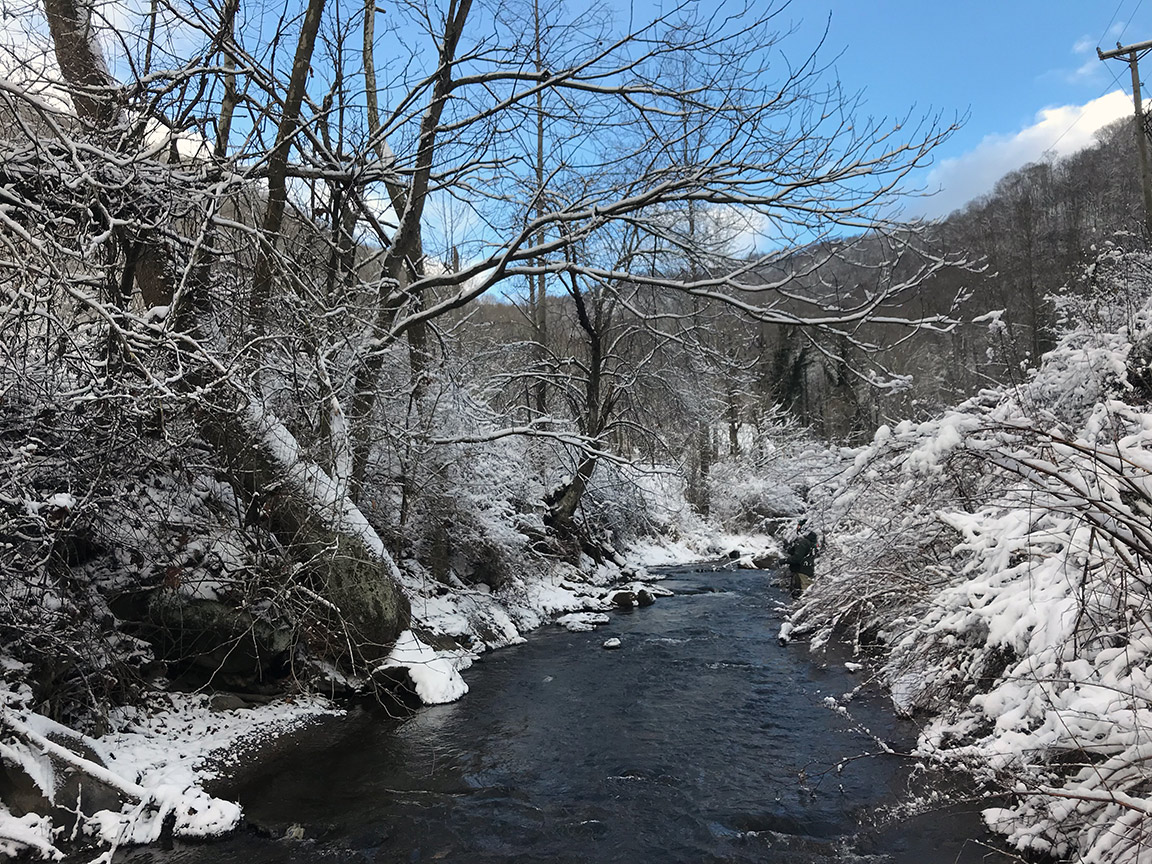Last January while fly fishing the Monocacy Creek, I reached down to scoop a wild brown trout from the water with my net and simultaneously watched my wading stick fall from my hands into the rushing water. It floated downstream ten yards before slowly disappearing under the water. I spent fifteen minutes looking for my lost wading stick before giving up and chalking it up to the third one I’d lost in the past six months. I could’ve never known that losing that wading stick would lead me to fly fishing one of the most unique streams I’ve ever had the chance to fish, the Elkhorn Creek in West Virginia.
I wrote a blog entry here on Wooly Bugged about my trip to the Monocacy. A couple of weeks later a gentlemen named Todd Hubler read that entry and contacted me to ask which part of the stream I’d lost the stick on. I explained and figured I’d never hear from him again. Two weeks later I opened up my email one morning to find a picture of my wading stick and a message from Todd saying we should get together and fish so he could return it to me. I agreed and then life got in the way. I was busy and Todd and I weren’t able to connect. Several months later I had an open day to fish and I decided I’d head east to New Jersey to fly fish the Pequest River. The water conditions were terrible that day. The hatchery was supposed to have stocked the stream but they hadn’t. Before I left I decided I’d walk upstream and look at the hatchery outflow. As I worked my way downstream I saw a gentlemen casting dry flies at rising trout. I headed back across the stream so that I wouldn’t disturb him and then I heard “Wooly Bugged.” It was Todd Hubler fishing below me. I couldn’t believe it. We chatted and I said we must’ve been destined to fly fish together. It was during this conversation that Todd told me about a stream in West Virginia called the Elkhorn Creek. He spoke of a creek that flowed through the poorest county in West Virginia, McDowell County. It was an unregulated body of water that was populated with a large number of wild brown and rainbow trout. After meeting that day in New Jersey, Todd and I kept in touch and made plans to make a trip to the Elkhorn in early 2018.
In the early morning hours of February 2nd, I sat in my truck making the almost seven hour drive to southwestern West Virginia. I’d done quite a bit of research on the Elkhorn Creek prior to leaving and found the place intriguing. The Elkhorn and its trout have a serendipitous beginning, and while all the details cannot be confirmed and will be argued about, the story goes something like this. In the early 1970s a trout stocking truck from the West Virginia Conservation Agency was driving down Rt. 52 through McDowell County. Where that truck was heading no one will ever remember, but at some point the truck broke down and couldn’t make it to its final destination. Because of the remoteness of the area, there was no way the payload of fish could be saved. Not far from the truck was a stonewall left over from the coal era and next to that wall flowed the Elkhorn. The driver decided that rather than let the fish die, he’d dump them in the creek and at least give the locals a good week of fishing. The rest is history. That payload of rainbow and brown trout went on to thrive and populate the entire length of the Elkhorn Creek. The existence of these fish went mostly unnoticed until the state was conducting a stream study and they were surprised when they found large brown trout living in this small body of water. The stream sort of became a secret among locals and eventually some TU members fished it and shared it with close friends. There are many unique stories from the early days on the Elkhorn. Todd shared a story of the time a guy crashed his GEO Metro into the Elkhorn. This car stayed in the stream for some time and the wild trout took up residence in and around it. At one point he said you could drift a fly right off the back bumper and watch a wild trout rise and take. All these stories simply add to the mystique of the stream.
I arrived in Princeton West Virginia at 10AM on Friday morning. I met Todd and we loaded his gear into my truck and we headed down Rt. 52. It had snowed the night before and the snow was heavy on the tree branches. The mountains in West Virginia are steep, much steeper than what you’ll find in Pennsylvania. The further northwest we drove the deeper we went into the coal country of West Virginia. McDowell County has quite a history. During the early part of the 20th century they found coal in the mountains. This brought great prosperity and thousands of jobs to the area. Coal mines popped up in the hollows, and railroads, houses, and general stores were built. At one point McDowell County was one of the wealthiest counties in the U.S. But then as technology changed the way that coal was mined, things changed and between the 1960s and 1990s tens of thousands of jobs disappeared from the area. An area that was once vibrant with life and progress suddenly took a turn for the worse. The lights at the coal mining facilities went dark, the wealth disappeared, and McDowell County changed. Drugs became a large problem and the area disappeared from the public eye.
This history was swirling through my head as Todd and I drove through the small towns of Bramwell, Switchback, and Elkhorn. You can see the remnants of the coal industry there. While some mines are still operational, many are closed. The old buildings line the landscape. As we got closer to our destination I observed many concrete and stonewalls along the Elkhorn creek. The mountains of West Virginia have taken back their stream. Eventually Todd saw a pull off he recognized and we got out and rigged our fly rods and tried to put on waders in air temps that were below 30 degrees. Once we were ready to go I followed Todd down the road as he tried to locate an entry point he’d used years ago. The stream bank was very overgrown and would probably be impossible to access in the summer months. He found a steep embankment down to the stream and I slid down into the water. The Elkhorn has another downside to it. McDowell County does not have a public sewer system. Many of the residents living along the stream have straight pipes that run human waste, bath and sink water right into the stream. Many of the locals affectionately refer to the Elkhorn as “The Sewer.” There is also a significant amount of trash in the stream as there are no dumps or public trash pick-up in the area. Ironically the sewage in the stream seems to add to the lore of the place, as it seems to aid in what is a very vibrant bug life. Almost any and every type of mayfly you can imagine hatches on the Elkhorn. Lifting an old blanket out of the stream will reveal a large number of aquatic nymphs.
The first run I fished on the Elkhorn Creek.
A nine-foot fly rod is too long for the upper portions of the Elkhorn. I used my 8’-4wt but a 7’ rod would’ve even been better. I decided to start out by fishing a #18 Red Brassie tied off of a #16 Tan Hare’s Ear pattern. Todd let me take the first several casts upstream into a beautiful run. As a freight train blew its whistle not more than a few yard away, I hooked up with my first Elkhorn Creek trout. It was incredible to hook up with a wild trout in this setting. My first fish turned out to be a rainbow. The fish looked very healthy and after releasing her I was back to drifting my nymphs. The next cast I was into another fish, a stronger fish. This turned out to be a solid wild bow that was over 12” in length. The fight in this fish for early February was incredible.
The first wild trout I caught on the Elkhorn Creek, a small rainbow.
The second larger wild rainbow I caught on a Red Brassie Nymph.
Fishing between the stonewalls that line this stream was an incredible experience. I followed Todd as we fished upstream along old concrete abutments and stonewalls. There were so many attempted takes by trout it was hard to count. We caught almost all wild rainbows in this first section we fished. Todd explained that there seem to be specific sections of the creek where the rainbows have taken root and other areas where just the brown trout are. After catching a good number of fish, Todd and I decided to change spots and eat a sandwich. After exiting the stream we washed our hands and used hand sanitizer. Some guys that fish this stream go as far as fishing with rubber gloves on. Either way, it is important to not get the water in your mouth as the stream carries fecal coliforms and things like Giardia (Beaver Fever). Don’t ignore this warning! I promise you, you will regret it.
The stonewalls that were built during the coal era to protect from flooding.
That afternoon Todd took me to a section of the Elkhorn that held more brown trout. The stream ran behind small homes, some of which it was hard to believe people inhabited. There is some serious poverty in this part of West Virginia, but the folks there have a way of life and are very cordial and friendly when they see you. We spent the afternoon drifting nymphs under indicators through runs and riffles. We fished under house foundations that stuck out over the stream and caught some beautiful wild brown trout that had a coloration that can only be found on the Elkhorn Creek.
The house with the foundation that stuck out over the stream.
That night Todd and I crashed in a hotel in Princeton and we were up the next morning at sunrise to head back into the mountains. On Saturday morning Todd took me further upstream closer to the start of the Elkhorn Creek. The Elkhorn starts as a spring that flows from an old coal mine. This in itself is amazing. Many other streams in the mountains suffer from acid mine drainage and have a deadly orange glow to them that supports no life. Somehow, the spring that feeds the Elkhorn is clean and it allows for miles of cold trout water that sees 40-50 degree temps almost year round on its was to the Tug Fork River. Upstream the Elkhorn gets very narrow and smaller fly rods are even more critical.
The view on the upper reaches of the Elkhorn Creek.
It is very difficult to find access to the water because of the brush, briars, trees, etc. Once you get onto the stream, a canopy of tree branches envelops you. There is some beautiful water hiding here and it is no wonder there are large trout that can live in this water. We worked our way upstream and caught a handful of wild brown trout. There are some large old concrete forms and foundations that are overgrown with weeds and trees now that the stream flows past. It makes for a unique backdrop and the trout love to hide next to them. Eventually Todd and I had enough of getting tangled in the trees while trying to put perfect drifts in tight areas. Todd wanted to head downstream and show me areas where the Elkhorn opens up to wider and deeper water and fabled larger fish.
One of the concrete walls that feels out of place on the Elkhorn.
We headed a few miles downstream and jumped in the water. There was a nice deep flow of water below the highway underpass and I could actually see a couple of large brown trout feeding in the shallow water near the bank. I cast my nymphs upstream of them and immediately one of the brown trout went after my indicator and two times tried to take it, taking it almost to the bottom of the stream. Todd suggested floating a glow bug on top of the water. I tied on a #14 Pink Glow Bug and cast again upstream. This time the fish took again but the hook didn’t hold and I watched a beautiful wild brown trout sink below the surface. On the Elkhorn, once the trout feels the hook, you’re unlikely to see them again. On my next cast however the glow bug sank and I saw a good-sized wild rainbow dart off the bottom and take the pattern. It was awesome.
Todd and I split up to cover move water for the rest of the morning. I caught numerous wild rainbow trout that morning. By lunchtime we’d met back up and fished more water together. We intermittently caught fish throughout the afternoon. We didn’t catch any giants although at one point Todd had a fish almost yank his rod out of his hands and he swears it was a giant. The closer to the Tug Fork River you get, the water gets much deeper and the opportunity for larger trout certainly increases.
Todd and I fished into the early evening hours until the sun had dropped below the mountains and we could barely see the freight train rolling buy on a bridge above us. At that moment I wished I had an additional day or two to explore more of the stream. We drove out of the mountains and Todd told of a day he’d caught a 100 fish back in the 1980s. After dropping Todd off, I started my long trek home. It was a unique experience and one I’ll never forget. Thanks for sharing Todd.














